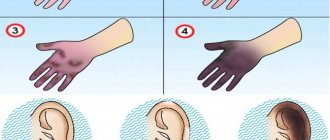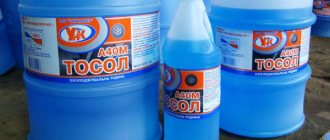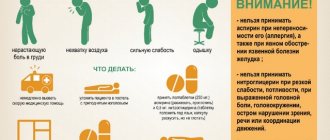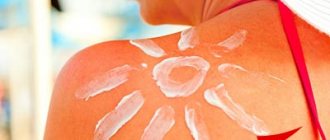A chemical burn occurs when a corrosive chemical reagent penetrates the skin layers. Such a burn can be obtained both at home and during industrial work.
Chemicals cause burns
The most aggressive chemicals are:
- acids;
- alkalis (in saturated form);
- metal salts.
A certain degree of burn is assigned depending on what percentage of the body area is affected and whether that area can recover.
Chemical paint burn
Degrees of chemical burns:
- First degree. The top layer of skin is damaged. This degree does not have serious consequences for the patient’s health. Treatment can be carried out at home, but after consulting a doctor.
- Second degree. The second layer of the skin, the dermis, is damaged, but the blood vessels and nerves are not affected. With this type of chemical burn, redness and blisters already appear. The pain becomes acute. Home treatment is contraindicated. Specialist supervision is required.
- Third degree. The papillary layer is damaged. The corrosive substance penetrated quite deeply. Nerve endings are affected.
- Fourth degree. The third and fourth degree chemical burns are similar in symptoms and it can be extremely difficult to distinguish them from each other. Muscles and tendons are affected, and the wound may penetrate to the bone.
How to identify a 3rd degree chemical burn
3rd degree chemical burns are divided into type A and type B. These subcategories also describe what a 3rd degree chemical burn looks like.
1) Type A: the upper layer of skin (epidermis) is injured. The lower layers are not damaged and are able to renew themselves. However, even after complete recovery, scars remain on the skin. With this type of burn, there is striking redness of the affected area, as well as a large number of blood blisters, from which a gray mucous fluid may be released. All symptoms are accompanied by severe pain.
3rd degree burn with solvent
1) Type B: in addition to the epidermis, the dermis and subcutaneous fat are damaged. Self-healing is impossible. It cannot be done without surgical intervention. The blood blisters become much larger, a dead crust begins to appear, and striking redness and swelling appear. Often the pain is so severe that painkillers are indispensable. Blood pressure drops and breathing becomes difficult.
ATTENTION! THIRD DEGREE CHEMICAL BURN IS THE MOST DANGEROUS. BECAUSE THE CORROSIVE REAGENT SHOWS ITS EFFECT NOT ONLY WHEN ITS DIRECT ITS CONTACT WITH THE SKIN AREA, BUT ALSO AFTER IT, FOR SEVERAL DAYS. CHEMICAL BURNS AFFECTING A LARGE AREA OF SKIN ARE LIFE THREATENING.
First aid
Regardless of the severity of the burn, the victim needs help.
First aid for first- and second-degree burns caused by high temperatures involves cooling the burned surface with cool water, preferably in the bathroom, but a stream of water will do.
This procedure should be carried out 3-6 times for 3-5 minutes until the pain subsides. After this, apply a clean bandage - gauze or bandage; if they are unavailable, ordinary cotton will do. If the victim complains of severe pain, you can give any painkiller - Ibuprofen, Analgin.
With these types of burns, a person usually does not see a doctor. After a few hours, the pain subsides, the bandage can be removed and, if necessary, treatment with special medications, for example, “Rescuer” ointment, can be started.
It is strictly forbidden to puncture the blisters, otherwise you can get an infection on the wound surface and you will have to treat sepsis (blood poisoning). The application of oils, alcohol, and soap is also not recommended; this can lead to deeper necrotic processes and slow down wound healing.
Providing first aid for third and fourth degree burns caused by high temperatures. Here a person receives serious burns, usually in an extreme situation, so before the ambulance arrives, calm down and remember: the life of the victim depends on the timeliness and correctness of your actions.
First of all, you need to eliminate the damaging factor. We quickly tear off the burning clothes or fill them with water, cover them with snow and sand. If the clothing is thick, throw a thick cloth (blanket, coat) over the victim, but do not aggravate the situation: do not throw the cloth over the head, otherwise the person will suffocate, and as soon as the flame goes out, immediately remove the blanket.
The victim is in panic and usually runs, the fire spreads at a faster rate, knock the person down and let him fall and roll on the ground.
Once the fire is out, continue to provide first aid. Anesthetize the victim to prevent pain shock; any painkiller will do. If possible, cover the burn areas with a clean cloth.
If this happens indoors, take the victim to fresh air so that he does not get poisoned by combustion products. Monitor breathing and heartbeat; if absent, begin artificial ventilation and cardiac massage until the doctor arrives. It is strictly forbidden to tear off clothes stuck to the skin, so as not to cause even deeper damage.
Other treatments
At later stages of healing of a chemical burn, physiotherapy can be used in the form of exposure to infrared waves, ultraviolet and ultrasound. Your doctor will create a treatment plan.
Surgical treatment may include: amputation, necrotomy (excision of the crust that appears on the surface of the skin), skin transplantation (in cases where a large area of the body surface is damaged, transplantation of one’s own or donor skin is possible), etc.
Chemical burn: causes of the disease, main symptoms, treatment and prevention
A chemical burn is damage to the skin due to exposure of human skin to aggressive active substances.
It is quite easy to get such an injury, and in everyday life we are surrounded by a large number of different chemicals that can destroy the integument of the epidermis.
Extensive skin damage can cause serious complications and irreversible consequences for human health.
Chemical burns to the body are the result of exposure to chemicals on the skin. A small amount of such substances can lead to the destruction of stem cells and the death of the damaged skin area. These burns often affect the face, head, cornea, conjunctiva, arms, legs, or torso.
There are cases when chemical exposure damages the eyes, oral cavity, mucous membrane of the esophagus, larynx, stomach or other internal organs.
Chemical injuries can subsequently leave different marks. It all depends on the active substance, the location of the injury, the area affected, the depth of penetration, as well as the timeliness and quality of medical care provided to the victim. The results of damage to the dermis can be seen in the photo on the Internet.
Chemical damage to the skin can be caused by substances and plants such as:
- vinegar;
- kerosene;
- lemon acid;
- potassium permanganate;
- deodorant;
- petrol;
- bitumen;
- dye;
- phosphorus;
- hydrochloric acid;
- welding;
- iodine;
- celandine;
- dimexide;
- hogweed;
- nettle;
- garlic juice;
- other chemicals.
You can get a burn after chemical peeling of the skin and facial cleansing, quartz lamp, radiation therapy, and laser equipment.
Dangerous injuries are considered to be burns resulting from skin exposure to alkaline substances and acids. They destroy the upper layers of the epidermis, causing great harm to human health, and lead to their dehydration.
The severity of a chemical burn is determined depending on the condition of the wound, the depth of penetration, the concentration of the aggressive substance, as well as the time of its exposure to the skin. According to the ICD-10 code (international classification of diseases), it has 4 degrees of damage, which are determined by clinical signs.
I degree. The first degree is characterized by damage to the upper layers of the skin. This type of injury does not carry any serious dangers or consequences. When you touch the damaged area, painful sensations appear. The main symptoms are:
- edema;
- staining the damaged area of skin bright red or pale pink;
- pain in the damaged area;
- burning sensation;
- increase in body temperature.
After a few days, profuse peeling is observed on the affected area. But the main sign of a first-degree chemical burn is the rapid and easy restoration of the skin.
II degree. The second stage manifests itself in the form of damage to the deeper layers of the epidermis, but without damage to the nervous and vascular structures. Without timely prehospital care and subsequent proper treatment in the clinic, patients may experience serious complications. The main signs of the second degree are:
- red spot on the skin;
- the appearance of huge formations in the form of bubbles with liquid;
- redness around the blister;
- increase in body temperature in damaged areas of the body;
- lethargy;
- severe pain syndrome.
The main sign of the second degree is blisters. If they burst, there is a possibility of introducing various types of infection.
Important: under no circumstances should you remove or open the resulting bubbles yourself. Open wounds can cause infection and further infection for the patient.
III degree. At the third stage, the deep layers of the epidermis are injured, along with the elements that participate in microcirculation. The skin will not recover on its own. The only way to heal the wound and get rid of scars is to undergo skin grafting in a clinic. From a 3rd degree chemical burn, the victim experiences the following symptoms:
- increased body temperature;
- fog;
- strong pain;
- labored breathing;
- lack of appetite;
- constriction of the pupils;
- general weakness.
Hazards of degree 2-3 are a high probability of serious injuries that will negatively affect the victim’s quality of life, especially if these are eye injuries.
IV degree. The fourth degree is the most dangerous for human health and life. Signs of a chemical burn are damage to a person’s skin, muscles and even tendons. After receiving 4th degree burns, a person’s quality of life deteriorates significantly, and no surgery or other methods will help get rid of the scars and completely cure the patient.
3rd-4th degree burns require emergency medical attention. Only in a hospital is it possible to begin treatment and determine methods of physical recovery of the victim. In case of chemical damage to the skin, pre-medical treatment of the wound is also necessary. To do this, you need to rinse the affected area with clean water and wait for the ambulance to arrive.
Depending on the substance that caused the burn, first aid methods are determined:
- Thermal burn is the result of exposure to steam, boiling water, hot liquids, sunlight, iron and other household items. Looking at the step-by-step instructions, the first step is to rinse the damaged area under running water. This procedure should be performed for about 15 minutes. Then remove clothing or other objects that are in the damaged area.
- An acid burn should be treated in the same sequence. Rinse with clean water, even if only a drop of the substance gets on your skin. Then the damaged surface can be treated with a weak 2% soda solution. To increase the effect of the previous treatment, at the next stage you can treat the wound with 0.5% ammonia.
- Alkali burns are one of the most dangerous. To cure and neutralize the substance, use acetic or citric acid in a 1-2% solution.
- Chemical poisoning. This damages the throat, tongue, lips, gums, pharynx, respiratory tract, nasal mucosa, stomach and other internal organs.
Treatment of chemical burns at home is carried out with mild degrees of skin damage. It is best to treat the affected tissue with an alcohol solution or oils.
Then the burned areas are covered with a sterile bandage.
If the burns are mild, for quick healing you can use lotions made from chamomile infusion, smear the sore areas with Panthenol cream or other drugs that were recommended by the attending physician.
For chemical damage, compresses and lotions from:
- lingonberry juice;
- apple puree;
- oak bark;
- cabbage leaves.
Mild burns and a small area of damage do not pose a danger to life. In any case, damage to the skin leaves scars and marks on the skin, which, judging by patient reviews, can only be gotten rid of through surgery.
It is always easier to prevent and briefly implement preventive measures than to treat a chemical burn. Prevention requires:
- use chemicals carefully;
- hide chemicals in hard-to-reach places;
- when contacting chemical products, use protective equipment (gloves, goggles);
- do not store chemicals with food;
- do not use questionable medications and ointments;
- ventilate rooms after using chemicals.
By following these rules, you can reduce the risk of injury and other consequences of contact with chemicals.
Many chemicals are powerful enough to destroy tissue in the human body. Concentrated acids and alkalis have the greatest destructive potential. When the human body is exposed to acids and alkalis, chemical burns occur.
First aid for chemical burns includes generously washing the burn site with running water to remove the aggressive substance, and applying a sterile bandage to the burn site. If the chemical was swallowed or got into the eyes, then in addition to washing the stomach or eyes, you should call an ambulance.
A chemical burn is tissue damage that occurs under the influence of acids, alkalis, heavy metal salts, caustic liquids and other chemically active substances. Chemical burns occur as a result of industrial injuries, safety violations, domestic accidents, as a result of suicide attempts, etc. The depth and severity of a chemical burn depends on:
- strength and mechanism of action of a chemical substance
- quantity and concentration of the chemical
- duration of exposure and degree of penetration of the chemical
Based on the severity and depth of tissue damage, burns are divided into 4 degrees:
- I degree (damage to the epidermis, the upper layer of skin). With a first-degree burn, there is slight redness, swelling and slight tenderness in the affected area of the skin.
- II degree (damage to deeper layers of skin). A second-degree burn is characterized by the appearance of blisters with transparent contents on the reddened and swollen skin.
- III degree (damage to the deeper layers of the skin down to the subcutaneous adipose tissue) is characterized by the appearance of blisters filled with cloudy liquid or bloody contents, and impaired sensitivity (the burn area is painless).
- IV degree burn (damage to all tissues: skin, muscles, tendons, even bones).
Most often, chemical skin burns are III and IV degree burns.
In case of burns with acids and alkalis, a scab (crust) forms at the burn site. The scab that forms after alkali burns is whitish, soft, loose, spreading to adjacent tissues without sharp boundaries.
Alkaline liquids are more destructive than acidic ones due to their ability to penetrate deep into tissues.
With acid burns, the scab is usually dry and hard, with a sharply demarcated line where it transitions to healthy areas of the skin. Acid burns are usually superficial.
The color of the affected skin in a chemical burn depends on the type of chemical agent. Skin burned with sulfuric acid is initially white, and subsequently changes color to gray or brown.
In case of a burn with nitric acid, the affected area of the skin has a light yellow-green or yellow-brown tint.
- The main rule for treating chemical burns, including at home, is to use medications only after consultation and examination by a doctor. For safety and positive effect, you should not self-medicate, risking your health and life.
- To treat chemical burns of the skin, it is recommended to lubricate the affected area with special medicinal ointments (Fuziderm, Solcoseryl). Burns caused by chemicals require subsequent cell regeneration and blood supply, which is what the action of the above ointments is aimed at.
- Preparations such as Bepanten, Panthenol, ichthyol ointment, and sea buckthorn oil also have an excellent restorative, disinfecting, healing and drying effect.
- Alcohol-free iodine or preparations containing silver have an antiseptic, disinfectant, drying and analgesic effect.
- There are also folk recipes that promote wound healing after thermal and chemical burns. These include compresses based on medicinal herbs: chamomile, oak bark, hop cones. Having prepared decoctions of these herbs, take a sterile bandage, moisten it and apply it to the wound for 15 minutes. You can prepare a medicinal ointment based on aloe leaves. To do this, take 2-3 aloe leaves, wash them, cut off the thorns and grind them into a “gruel”. Melted fat (pork or interior fat) is added to this mass; after cooling, the ointment is ready for use. It is still better to discuss the use of traditional recipes with your doctor.
Consequences of a chemical burn
The consequences of a 3rd degree chemical burn can be very destructive not only for the affected area of the skin, but also for the entire body. This occurs due to the content of toxic substances in chemical reagents.
Chemical burns to the eyes - what to do
Chemical burn 3rd degree, common consequences:
- Kidney disorder (dysfunction).
- Blood poisoning.
- Anaphylactic shock.
- Lung diseases.
- Poisoning.
First aid for burns
When a victim comes into contact with an aggressive environment, you must not hesitate for a minute, since first aid for a chemical burn must be provided as quickly as possible:
- Immediately remove all clothing and jewelry contaminated with the chemical.
- Rinse the affected area with running cold water for at least 20 minutes, except for contact with organic aluminum compounds - they ignite when interacting with water.
- It is strictly not recommended to remove substances from the surface of the skin with cotton swabs or wet wipes to avoid rubbing it into the skin.
- In case of contact with aggressive powdery substances (lime, for example), remove the powder and only then rinse the area of contact.
First aid for burns caused by chemical substances is to neutralize these substances:
- when interacting with acids, the affected area should be washed with alkaline solutions - tea soda diluted in water or soap solution;
- with alkalis - act with an acidic liquid, for example, vinegar solution or lemon juice;
- carbolic acid is neutralized with milk of lime or glycerin;
- lime - 20% sugar solution.
If the victim experiences pain after washing, you need to apply a cloth moistened with cold water to the injured area for several minutes, then apply a bandage from a sterile piece of gauze. For burns of I and II severity, the victim does not need hospitalization, and the consequences of the injury can be treated at home.
In severe cases, upon contact with an aggressive environment, it is necessary to call an ambulance and take with you a container with a chemical substance to identify the reagent.
First aid should be provided immediately for a chemical burn to the eyes:
- turn on the water with a weak stream;
- widen your eyelids as much as possible;
- rinse the eyes under running water for at least a quarter of an hour until the reagent is completely washed off.
As well as the stomach and esophagus, rinsing with plenty of liquid after neutralization. For acid poisoning, use alkaline solutions (baking soda); for alkaline poisoning, use an acidic solution (solutions of vinegar or lemon juice).
Prevention of chemical burns
If you are handling caustic chemicals, be sure to follow safety precautions. Workers in industries that use chemicals must receive appropriate instruction and learn how to work safely.
Burn prevention - remove hazardous substances
To avoid getting a chemical burn at home, you must:
- All bottles containing chemicals should be sealed and kept out of the reach of children.
- Do not allow chemicals to come into contact with food.
- When working with them, protect the entire surface of the body.
- Make sure that stored caustic substances do not evaporate. And if this does happen, open the windows and doors to ventilate the room.
Features of survival and autonomous existence in the wild
Main menu
Post navigation
Thermal burns are possible in everyday life and at work; especially severe burns occur during fires. The causes are usually careless handling of hot and flammable objects. Violation of safety regulations at work. Burns often occur when the skin is exposed to high-temperature factors, such as boiling water or tar, steam, fire, etc.
The depth, or severity, of the burn depends on the temperature of the damaging factor and how long it lasted. Depending on the depth of damage to the tissues of the human body, superficial and deep burns are distinguished.
Superficial burns include burns of I, II and IIIa degrees. Deep burns are burns of IIIb and IV degrees. First degree burns are characterized by redness of the skin and pain. With second degree burns, in addition to redness of the skin, blisters with transparent or jelly-like contents appear. IIIa degree burns are characterized by the appearance of superficial necrosis of the skin down to its deep layer. For first and second degree burns, conservative treatment is sufficient.
Healing of the burned surface of the body occurs without the formation (I, II degree burns) or with the formation (IIIa degree of burn) of barely noticeable superficial scars. If a IIIb degree burn occurs, skin necrosis occurs throughout its entire depth to the subcutaneous fat layer. For IV degree burns, the most important sign is tissue charring. This damages muscles and bones. Superficial burns, unlike deeper ones, are characterized by the fact that pain sensitivity is preserved. Victims react to pain when pricked with a needle, when touching the burn surface with a swab with a medicinal solution, or when pulling out a skin hair.
When determining the severity of a burn, not only its depth, but also its area are taken into account. To quickly determine the area of the burn surface, you need to know the rules of “palm” and “nines”. The rule of the “palm” is that its area in a person is about 1% of the surface of his body. According to the rule of nines, the area of the head and neck is approximately 9%, one arm - 9% (both - 18%), the front surface of the body - 18%, the back surface of the body - 18%, one leg - 18% (both legs - 36 %), perineum – 1%.
If burns occupy at least 10% of the body surface in adults and at least 5% in children and the elderly, burn disease may develop. A characteristic clinical picture of burn shock appears if the area of superficial burns is 15–20%, and deep burns are more than 10% of the body surface. Victims experience anxiety and agitation. They complain of excruciating pain and severe thirst. The skin and mucous membranes are pale, with a bluish tint. Severe shortness of breath, rapid heartbeat, and signs of increasing suffocation occur with burns of the face, neck and chest.
The burned person must be placed on a shield or stretcher. If pieces of debris and clothing are stuck to the burn site, they should not be removed. It is necessary to apply a sterile bandage to the burned part of the body, and if the burn surface is large, wrap the victim in a sterile (or ironed on both sides) sheet. If there are extensive burns of degrees I, II and IIIa, i.e. superficial, then the bandages should be moistened with sterile saline solution or 0.5–1% novocaine solution.
Painkillers (1% promedol solution, 50% metamizole sodium solution), sedatives (0.25% droperidol solution, 1% diphenhydramine solution or 0.25% promethazine solution) are administered intravenously; inhalations are performed with a mixture of nitrous oxide and oxygen in a ratio of 1 1. If there are deep burns of the extremities, then transport fixation of the extremity is carried out, and a supply of humidified oxygen is also necessary.
For severe (deep and/or extensive) burns, polyglucin, rheopolyglucin, solutions of albumin, aminophylline, cardiac and respiratory agents (strophanthin solution, cordiamin) are administered intravenously. An urgent evacuation of the victim to a burn or surgical department is carried out, and anti-tetanus serum is necessarily administered.
Chemical burns are most often caused by concentrated solutions of acids and alkalis. The causes of chemical burns in everyday life and at work are careless handling of chemicals and violations of safety regulations. The severity criteria for chemical burns, as well as thermal ones, are their depth and area in accordance with the provisions stated above.
High concentration acid solutions when exposed to soft tissues of the body cause necrosis in the form of a dense dry scab, and alkali solutions - in the form of a soft wet scab. In some cases, the smell of various chemical compounds emanates from the wound. A distinctive feature of the effect of certain acids on the skin is the appearance of a scab of a certain color. If a chemical burn is caused by sulfuric acid, then the scab is dark brown, if it is caused by hydrochloric acid, it is grayish white, and if it is caused by nitric acid, it is light brown.
The main goal of emergency care is to remove the chemical solution that caused the burn. It can be removed by washing the damaged area of the body with a stream of water. It is not recommended to neutralize acids and alkalis on the victim’s body. The reaction between acids and alkalis occurs with the release of heat, which will increase tissue damage. After washing the damaged part of the body, you need to apply a sterile bandage and administer painkillers (solutions of metamizole sodium, tramadol). The victim should be taken to the surgical or burn department of the hospital.
Based on materials from the book “Quick Help in Emergency Situations.” Kashin S.P.
A chemical burn is the result of overexposure to hazardous chemicals. In such a situation, an immediate response is necessary. First aid for chemical burns consists of a set of measures, as a result of which the victim’s condition improves. To ensure that the prehospital care provided does not cause harm to the person, it is necessary to understand the entire procedure for action in such a situation.
Treatment with folk remedies
If chemical burns are not significant, then you can freely turn to the methods used by our ancestors for help. They conceal healing methods that we often simply do not notice. After all, in ancient times medicine was not yet so widely developed, people were treated with whatever they could.
For example, vegetable oil and wax, in a 2:1 ratio, will help get rid of redness and blisters. Apply this mixture to the burn site and bandage it lightly. Pork fat and good ground coffee also help with wounds and blisters. Coat the burn area with fat, sprinkle a little coffee on top and bandage it too. With regular use, there will be no trace left of burn wounds.
Signs and characteristics of chemical burns
Symptoms appear immediately after exposure to chemical components and may become more severe over time. Signs depend on the degree and location of the lesion and on what kind of acid gets on the skin or mucous membranes:
- When exposed to sulfuric acid, the surface turns white and then acquires a gray tint. If contact lasts for a long time, a brown scab will form;
- Nitric acid promotes the formation of a yellow-green or brown-yellow scab;
- Salt is characterized by a yellow tint to damaged tissues;
- When exposed to acetic acid, a dark brown crust forms.
Acid burns usually cause less harm because the dangerous component rarely affects deep cells. The situation is different with alkalis. They penetrate much deeper into the tissue, causing the damage area to become wider. If a chemical reagent gets on the skin or mucous membranes, there is a risk that it will continue to be absorbed into the cells even after rinsing with water. Therefore, the diagnosis and extent of damage can be clarified only a week after the injury occurs.
Traditional first aid methods
Chemical burns with folk remedies must be treated with extreme caution. As part of this activity, it is necessary to use only those components that have neutral chemical properties. Otherwise, the course of the pathological process can be aggravated.
The following remedies are most often used for such skin lesions:
- Cut aloe leaf or juice.
- Lotions made from a decoction of calendula, chamomile, coltsfoot, string or nettle.
- Compresses made from grated carrots and potatoes, chopped onions and cabbage leaves, as well as pumpkin pulp.
- Herbal ointments based on honey or wax.
- Black tea lotions.
- Fir, sea buckthorn or almond oil.
Each of these remedies has its own therapeutic effect. For chemical burns, it is necessary to use folk recipes as part of complex treatment.
Important! The use of traditional methods of treatment does not eliminate the need to carry out initial treatment of a chemical burn with water and a neutralizer.
Uses of aloe
This plant can be used for almost any damage to the skin. In this case, you can use both aloe juice and its leaves. The juice is used to moisten gauze pads applied directly to the affected area. As for the leaves, they must be cut so that the pulp covers the largest possible area of the chemical burn.
Aloe leaves and juice will help relieve burn symptoms and promote skin healing.
The use of such a folk remedy allows you to reduce the severity of the inflammatory process, and also slightly reduces the level of pain in the affected area.
The use of coltsfoot, calendula, chamomile, nettle and string
These medicinal herbs have a calming effect on the skin, slowing down the development of the inflammatory process and accelerating the process of tissue regeneration. They are used for chemical burns as lotions. Before direct use, you must prepare a decoction of these herbs. In the future, they need to moisten gauze pads applied to the affected area.
Calendula decoction is great for making lotions for chemical burns.
Ointments based on honey and wax
Most often, such ointments are made from various medicinal herbs that have a calming effect. Often, for such purposes, various types of oils are used instead of herbs.
Wax for preparing ointments can be purchased in specialized stores or directly from beekeepers
One of the popular recipes for such ointments involves bringing one glass of vegetable oil to a boil. Subsequently, 1 onion cut into pieces is placed there. It must be removed immediately after it begins to turn golden brown. You need to add wax to the remaining oil. After it melts, turn off the stove and wait until the ointment cools down. Then the ointment is applied to the affected area of the skin.
Treatment of a chemical burn is quite a complex undertaking. That is why it is important not only to seek medical help in a timely manner, but also to have the skills to perform the first medical procedures.
Neutralization of aggressive substances
Before treating a chemical burn, it is necessary to find out what specific substance caused it. After washing, a procedure should be carried out to neutralize the active compounds remaining in the area of the skin lesion . It is carried out by various means, depending on the substance that caused the burn:
- If the skin is damaged by acids, it is necessary to treat the damaged area with a soda solution. To prepare it, you need to take 1 tablespoon of baking soda and dilute it in 2.5 glasses of water. If this substance is not available, ordinary soapy water can be used. You can also use a 0.5% solution of ammonia. An exception is lesions caused by carbolic acid. First aid for chemical burns of this type will involve treating the damaged skin area with glycerin. In addition, you can use lime milk.
- Providing first aid for chemical burns with alkalis involves neutralization with acids. For these purposes, it is necessary to use diluted acetic or citric acid.
- If the skin is damaged by any of the components of lime, it is necessary to treat the damaged area with a 20% sugar solution.
Neutralizing chemical residue on the skin will help limit the affected area
Important! If affected by an unknown substance, neutralization measures should not be carried out. If you make a mistake in choosing the right product, you can increase the size of the affected area.












